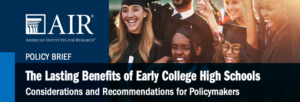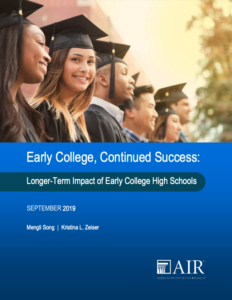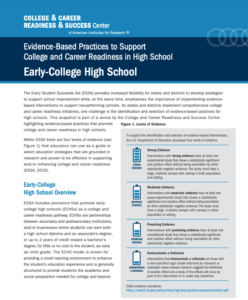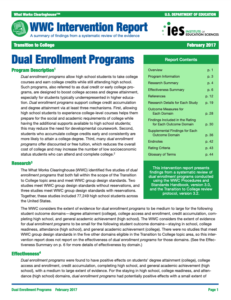Early College High School
Research References
Following up on a previous impact study of Early Colleges (EC) based on retrospective admission lotteries, this study assessed longer-term impacts on students’ postsecondary outcomes with 4 more years of data. The study found that students who won EC admission lotteries were significantly more likely to enroll in college, enroll in 2-year colleges, complete a college degree, complete associate’s degrees or certificates, and complete bachelor’s degrees within 6 years after expected high school graduation than control students. Moreover, it found that treatment students completed postsecondary degrees earlier and faster than control students. Consistent with EC’s focus on college exposure during high school, the EC impacts on college enrollment and the completion of associate’s degrees largely occurred within high school. The study also found that EC impacts did not vary significantly by students’ demographic characteristics; however, some impacts were significantly stronger for students with higher levels of prior achievement.
Mengli Song, Kristina Zeiser, Drew Atchison & Iliana Brodziak de Los Reyes. (2021). Early College, Continued Success: Longer-Term Impact of Early College High Schools, Journal of Research on Educational Effectiveness, 14:1, 116-142, DOI: 10.1080/19345747.2020.186237
Retrieved from https://journals.iupui.edu/index.php/muj/article/view/23815
Using an evidence-based approach, programs being launched now by colleges and universities focus on the core missions of early college and dual enrollment programs, connecting youth less likely to attend college directly out of high school with powerful programming that propels them towards successful completion of degrees and to the start of their career. This article presents perspectives from a range of institutions (high school, two-year institutions, four-year institutions, and philanthropic investors) that are rethinking these models to maximize community impact and affordability to students and families.
Cherney, I., Douglas, L., Fischer, E., & Olwell, R. (2020). Early College High School/Dual Enrollment 2.0: Evidence-Based Approaches to Engage Youth and Families for Educational, Career, and Community Development. All In: The Urban Mission, Philadelphia Conference Issue, 31(2), 18-32.
Retrieved from https://journals.iupui.edu/index.php/muj/article/view/23815
 In recent years, the American Institutes for Research (AIR) has conducted a rigorous impact evaluation (2013, 2014) and a follow-up study (2019), as well as a cost-benefit analysis (2019) of Early College High Schools. This brief summarizes key findings from this work and indicates implications and recommendations for federal and state policymakers.
In recent years, the American Institutes for Research (AIR) has conducted a rigorous impact evaluation (2013, 2014) and a follow-up study (2019), as well as a cost-benefit analysis (2019) of Early College High Schools. This brief summarizes key findings from this work and indicates implications and recommendations for federal and state policymakers.
American Institutes for Research. (2020). The Lasting Benefits and Strong Returns of Early College High Schools: Considerations and Recommendations for Policymakers. Washington, DC.
Retrieved from https://www.air.org/sites/default/files/downloads/report/Lasting-Benefits-Early-College-High-Schools-Brief-Feb-2020.pdf
Drawing on interview data and sensemaking theory, we explore the perspectives of 108 teachers working in eight early college high schools in a border region of Texas. Findings suggest teachers rely primarily on their personal and professional experience to make sense of college readiness, resulting in wide variation with respect to how they approach it in their classrooms. The article closes with implications for policy and practice.
Duncheon, J. C., & Munoz, J. (2019, May). Examining Teacher Perspectives on College Readiness in an Early College High School Context. American Journal of Education, 125(3), 453-478.
Retrieved from https://www.journals.uchicago.edu/doi/full/10.1086/702731
This study is a randomized controlled trial that assessed the impact of Early College High Schools on students’ high school graduation, college enrollment, and college degree attainment, as well as students’ high school experiences using extant data and survey data. The study included 10 Early Colleges that enrolled students in Grades 9 to 12 in 2005 through 2011 and used a lottery for admissions, and 2,458 students who participated in those admission lotteries. The study time frame covered Grade 9 through 2 years post high school for all students and 4 years post high school for the oldest student cohort. It found that Early Colleges had positive impacts on college enrollment and college completion as well as students’ high school experiences.
Haxton, C., Song, M., Zeiser, K., Berger, A., Turk-Bicakci, L., Garret, M. S., Knudsen, J., Hoshen, G. (2016). Longitudinal Findings from the Early College High School Initiative Impact Study. Educational Evaluation and Policy Analysis, 38(2), 410–430.
Retrieved from https://journals.sagepub.com/doi/10.3102/0162373716642861
This study examines the impacts of early college high schools, small schools of choice located on college campuses and reports generally promising findings. Early colleges increase important high school outcomes, boost associate’s degree completion, and raise 4-year-college enrollment at less selective public institutions. The report also shows the differences of these impacts across race, home-district performance, and host site, helping better understand the implementation and effects of this promising intervention in one state that has brought this school reform model to scale.
Lauen, D.L., Barrett, N., Fuller, S., Janda, L. (2017). Early Colleges at Scale: Impacts on Secondary and Postsecondary Outcomes. American Journal of Education, 123(4), 523-551.
Retrieved from https://www.journals.uchicago.edu/doi/10.1086/692664
 Timken Early College High School (TECHS) was envisioned not just as a school, but as a culture shifting community “proof-point” that low income, first generation, inner city students can be successful with college-level work. Further, TECHS has afforded students an opportunity to earn both a diploma and an associate degree during their high school career. Five hundred forty two students have graduated TECHS since 2009. Nearly all of the 73 members of the graduating class of 2018 were from populations underrepresented in higher education. Of the 2018 class, 100% were economically disadvantaged and 44% were minorities. Further, 77% were first generation students. TECHS students continue to outperform other early college high schools across the state and nation on key indicators — graduating high school on-time, graduating with college credit and graduating with an associate degree.
Timken Early College High School (TECHS) was envisioned not just as a school, but as a culture shifting community “proof-point” that low income, first generation, inner city students can be successful with college-level work. Further, TECHS has afforded students an opportunity to earn both a diploma and an associate degree during their high school career. Five hundred forty two students have graduated TECHS since 2009. Nearly all of the 73 members of the graduating class of 2018 were from populations underrepresented in higher education. Of the 2018 class, 100% were economically disadvantaged and 44% were minorities. Further, 77% were first generation students. TECHS students continue to outperform other early college high schools across the state and nation on key indicators — graduating high school on-time, graduating with college credit and graduating with an associate degree.
Stark Education Partnership. (2019). Decade of Proof: The First Ten Graduating Classes of Timken Early College High School.
Retrieved from https://files.eric.ed.gov/fulltext/ED594455.pdf
High school reform in the United States has a long and unremarkable history with regard to improving the outcomes of traditionally underrepresented youth. Beginning in 2002, North Carolina began to implement the Early College High School model. In 2012 the state of North Carolina adopted a new accountability program that includes the ACT as a measure of college readiness in addition to the long-standing end-of-course assessments in English, algebra, and biology. This study examines four years of performance outcomes using the North Carolina End of Grade Tests and one year of ACT results for all students in the testing program.
Kaniuka, T. (2017). Early college high school achievement outcomes in North Carolina: End of grade and ACT performance. International Journal of Research Studies in Education, 6(4), 91–107.
 Building on a previous randomized experiment of the impact of Early Colleges (ECs) (Berger et al., 2013), this follow-up study assessed longer-term impacts of ECs on students’ postsecondary outcomes 6 years after expected high school graduation.
Building on a previous randomized experiment of the impact of Early Colleges (ECs) (Berger et al., 2013), this follow-up study assessed longer-term impacts of ECs on students’ postsecondary outcomes 6 years after expected high school graduation.
Song, M., & Zeiser, K. (2019). Early College, Continued Success: Longer-Term Impact of Early College High Schools. Washington, DC: American Institutes for Research.
 The College and Career Readiness and Success Center highlights evidence-based practices that promote college and career readiness in high schools. This brief focuses on early college high schools which are partnerships between secondary and postsecondary institutions and businesses that allow students to earn both a high-school diploma and an associate’s degree or postsecondary credit towards a bachelor’s degree. This evidence-based practice provides a learning environment that enhances students’ education experience and improves student outcomes in high school and postsecondary education.
The College and Career Readiness and Success Center highlights evidence-based practices that promote college and career readiness in high schools. This brief focuses on early college high schools which are partnerships between secondary and postsecondary institutions and businesses that allow students to earn both a high-school diploma and an associate’s degree or postsecondary credit towards a bachelor’s degree. This evidence-based practice provides a learning environment that enhances students’ education experience and improves student outcomes in high school and postsecondary education.
College & Career Readiness & Success Center at American Institutes for Research. (2017). Evidence-Based Practices to Support College and Career Readiness in High School: Early-College High School. Washington, DC.
Retrieved from https://files.eric.ed.gov/fulltext/ED586413.pdf
 Early College High Schools (ECHSs) and dual-enrollment programs allow students to take college courses while still in high school. Research has shown that students participating in these programs are more likely to enroll in college, post higher college grade point averages, persist, and ultimately graduate from college. This report recommends that Congress consider a pilot program that would allow high school students to use federal Pell Grants to pay for college courses.
Early College High Schools (ECHSs) and dual-enrollment programs allow students to take college courses while still in high school. Research has shown that students participating in these programs are more likely to enroll in college, post higher college grade point averages, persist, and ultimately graduate from college. This report recommends that Congress consider a pilot program that would allow high school students to use federal Pell Grants to pay for college courses.
John Hopkins Institute for Education Policy. (2018). Now’s the Time: Early College and Dual-Enrollment Programs in the Higher Education Act. Washington, DC: Alliance for Excellent Education.
Developed in response to concerns that too few students were enrolling and succeeding in postsecondary education, early college high schools are small schools that blur the line between high school and college. This article presents results from a longitudinal experimental study comparing outcomes for students accepted to an early college through a lottery process with outcomes for students who were not accepted through the lottery and enrolled in high school elsewhere. Results show that treatment students attained significantly more college credits while in high school, and graduated from high school, enrolled in postsecondary education, and received postsecondary credentials at higher rates.
Edmunds, J., Unlu, F., Glennie, E., Bernstein, L., Fesler, L., Furey, J., Arshavsky, N. (2017). Smoothing the Transition to Postsecondary Education: The Impact of the Early College Model. Journal of Research on Educational Effectiveness, 10(2), 297-325.
Retrieved from https://www.tandfonline.com/doi/abs/10.1080/19345747.2016.1191574?journalCode=uree20
 Despite their name, early college high schools aren’t really college or high school but a hybrid of both. All students take both high school and colleges classes simultaneously. Sometimes a single class, such as 11th grade “algebra II” or 12th grade English, can earn a student credit toward both high school and college. Most early college high schools are small public schools, housing grades nine to 12 just like traditional public high schools, though some extend five years. When it comes time for high school graduation, many students have earned enough college credits to leave not only with a traditional high school diploma but also with a two-year associate degree. For students, that’s a degree with zero tuition.
Despite their name, early college high schools aren’t really college or high school but a hybrid of both. All students take both high school and colleges classes simultaneously. Sometimes a single class, such as 11th grade “algebra II” or 12th grade English, can earn a student credit toward both high school and college. Most early college high schools are small public schools, housing grades nine to 12 just like traditional public high schools, though some extend five years. When it comes time for high school graduation, many students have earned enough college credits to leave not only with a traditional high school diploma but also with a two-year associate degree. For students, that’s a degree with zero tuition.
Barshay, J. (2020). Research on Early College High Schools Indicates They May Pay for Themselves in the Long Run. The Hechinger Report.
Retrieved from https://hechingerreport.org/research-on-early-college-high-schools-indicates-they-may-pay-for-themselves-in-the-long-run/
 Dual enrollment programs were found to have positive effects on students’ degree attainment (college), college access and enrollment, credit accumulation, completing high school, and general academic achievement (high school), with a medium to large extent of evidence. This is a summary of findings from a systematic review of the evidence as reported in this What Works Clearinghouse Intervention Report.
Dual enrollment programs were found to have positive effects on students’ degree attainment (college), college access and enrollment, credit accumulation, completing high school, and general academic achievement (high school), with a medium to large extent of evidence. This is a summary of findings from a systematic review of the evidence as reported in this What Works Clearinghouse Intervention Report.
Development Services Group, Inc. (2017). Dual Enrollment Programs: Transition to College. Washington, DC: Institute of Education Sciences.
Additional Research References
- Berger, A., Adelman, N., & Cole, S. (2010). The Early College High School Initiative: An Overview of Five Evaluation Years. Peabody Journal of Education, 85(3), 333–347. https://doi.org/10.1080/0161956X.2010.491697
- Conley, D. T. (2012). A Complete Definition of College and Career Readiness. Educational Policy Improvement Center. Retrieved from http://eric.ed.gov/?id=ED537876
- Edmunds, J. A., Bernstein, L., Glennie, E., Willse, J., Arshavsky, N., Unlu, F., … Dallas, A. (2010). Preparing Students for College: The Implementation and Impact of the Early College High School Model. Peabody Journal of Education, 85(3), 348–364. https://doi.org/10.1080/0161956X.2010.491702
- Edmunds, J. A., Bernstein, L., Unlu, F., Glennie, E., Willse, J., Smith, A., & Arshavsky, N. (2012). Expanding the Start of the College Pipeline: Ninth-Grade Findings From an Experimental Study of the Impact of the Early College High School Model. Journal of Research on Educational Effectiveness, 5(2), 136–159. https://doi.org/10.1080/19345747.2012.656182
- Kaniuka, T. S., & Vickers, M. (2010). Lessons Learned: How Early College High Schools Offer a Pathway for High School Reform. NASSP Bulletin, 0192636510384982. https://doi.org/10.1080/0161956X.2010.491702
- Ongaga, K. O. (2010). Students’ Learning Experiences in an Early College High School. Peabody Journal of Education, 85(3), 375–388. https://doi.org/10.1080/0161956X.2010.491708
- Thompson, C., & Ongaga, K. (2011). “Flying the Plane While We Build It”: A Case Study of an Early College High School. The High School Journal, 94(2), 43–57. https://doi.org/10.1353/hsj.2011.0000
- Bridges, J. M., & Maxwell, G. M. (2015). Early college high schools: A proposed solution to secondary transition services . Journal of Case Studies in Education, 8. Retrieved from https://files.eric.ed.gov/fulltext/EJ1110965.pdf
- Zinth, J. (2016). Early College High Schools: Model policy components. Denver, CO: Education Commission of the States. Retrieved from https://files.eric.ed.gov/fulltext/ED569132.pdf
- Early College Design Services. (2014). “Early College High Schools Get Results.” Retrieved from https://ns4ed.s3.us-east-2.amazonaws.com/echs/echs-one-pager-stats-2014.pdf
- Berger, A, Turk-Bicakci, L, etc. (2013). “Early College, Early Success: Early College High School Initiative Impact Study.” Retrieved from https://ns4ed.s3.us-east-2.amazonaws.com/echs/echs_impact_study_sep2013.pdf
- Association for Career & Technical Education. (2016). “Career and Technical Education Improves Student Achievement in High School, College and Career.” Retrieved from https://ns4ed.s3.us-east-2.amazonaws.com/echs/acte_cte-fs-2016-final.pdf